Cryptocurrencies might be a bubble, but they’re here to stay
John Stepek looks at how the main asset price charts are faring ahead of the weekend, starting with bitcoin's recent meteoric rise.


A quick pre-bank holiday rundown of our "charts that matter" this week. And I think we shouldstart with the jaw dropper our old friend, bitcoin.
It's fair to say that this one's going parabolic.
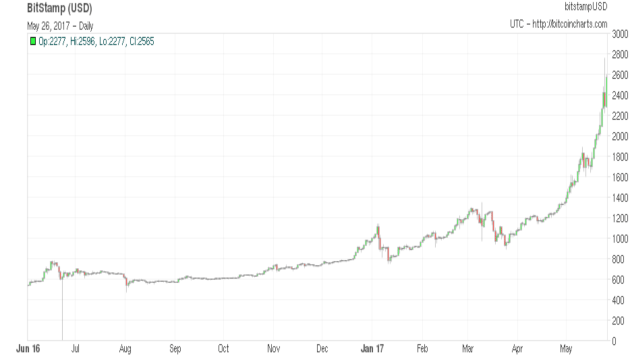
(Source: bitcoincharts.com)
MoneyWeek
Subscribe to MoneyWeek today and get your first six magazine issues absolutely FREE

Sign up to Money Morning
Don't miss the latest investment and personal finances news, market analysis, plus money-saving tips with our free twice-daily newsletter
Don't miss the latest investment and personal finances news, market analysis, plus money-saving tips with our free twice-daily newsletter
And it's not the only cryptocurrency that's had a great year so far. Far from it.
The total dollar value (or market capitalisation, if you like) of all cryptocurrencies in issue has gone from less than $25bn at the start of this year to more than $75bn now.
Charts that look like the one above rarely end well (the Nasdaq circa the late 1990s is one example. Japan in the late 1980s is another). But they also often herald the arrival of a new era and one of significant change.
Cryptocurrencies for all the scandal and all the hype aren't going to go away. Ben Thompson at Stratechery has a good post up in which he draws the same conclusion as I have. This might be a bubble, but if so, it's like the tech bubble the market might be getting ahead of itself, but it's the birthing pains of a useful new technology that we're now seeing.
By the way, if you're interested in actually investing in bitcoin andcryptocurrencies, I'd advise you to tread carefully. But you might also be interested in this presentation from one of my colleagues, Sam Volkering. Sam's a big tech evangelist and he's been following bitcoin since the very earliest days. You can find out more here.
By comparison, everything else was a little tame this week. After a strong comeback the previous week, gold was mostly flat.On the one hand, with stock markets hitting new highs and "sexy" things like cryptocurrencies rocketing, fewer people want to keep their money in boring, old gold.
On the other hand, there are still a lot of political jitters, and the US dollar has been relatively weak, so that's kept gold nicely propped up.
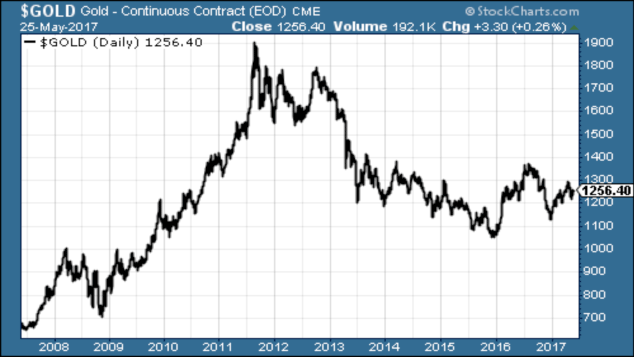
As the dollar has weakened and the wider market has become a little more bullish, the price ofcopper has picked up somewhat. But markets are still wary on the reflation trade. It's worth keeping an eye on China to see what happens here (and the pummelling the oil price took yesterday won't help either).
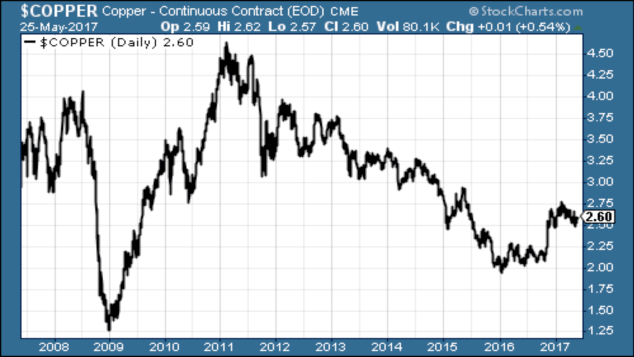
The US dollar had another faltering week. There were no surprises from the Federal Reserve to prop up the US currency when minutes from its latest meeting came out, and the euro has been making hay. We're probably due a pause in the action and it looks like we've had the beginnings of one but I reckon the weak dollar trend remains intact.
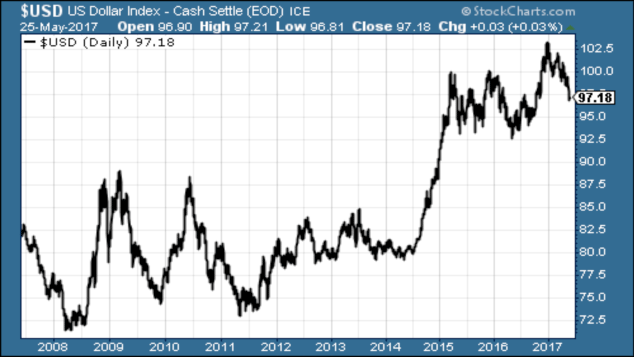
Meanwhile, yields on ten-year US Treasury bonds were little changed on the week they ended last week on 2.23%, and edged higher to 2.25%. The Fed, again, is partly responsible. The minutes from the US central bank's latest meeting suggested that there is still no huge rush to raise rates. Markets still don't see them as "behind the curve", but they're certainly not in a hurry to get ahead of it either.
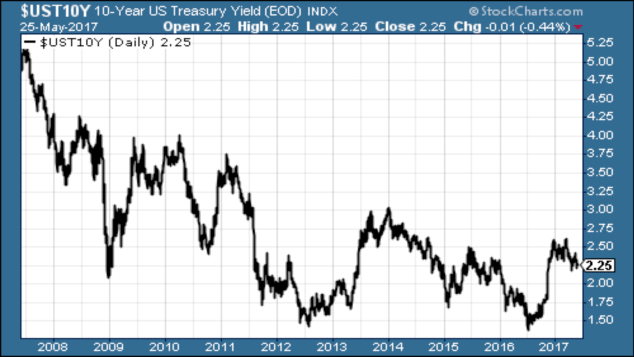
That brings us to the latestUS jobless claims data. David Rosenberg of Gluskin Sheff sees this is a valuable leading indicator. When the figure hits a "cyclical trough" (as measured by the four-week moving average), a stock market peak is not far behind, and a recession follows about a year later.
The thing is, up until recently, it looked as though jobless claims had troughed at just under 240,000 at the end of February. So we'd be looking at the market (the S&P 500) peaking around the end of May at least if you take an average of what's happened in the past.
But we've just hit a fresh low. Claims came in at 238,000 for the week ending 20 May.The four-week average is now at 235,250, its lowest level since April 1973.So if nothing else, if history repeats itself, we'vepushed the stock market peak back until the end of August.
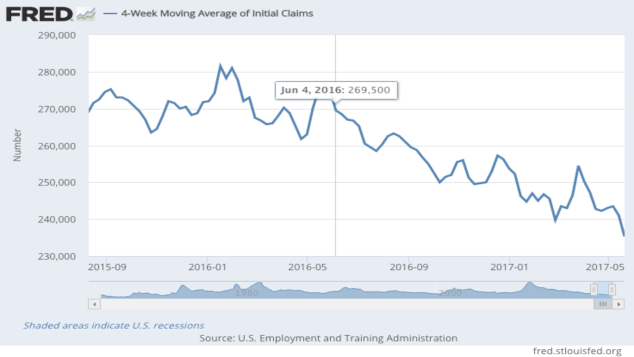
Obviously, this is a very loose measure, based on a small historical sample (and therefore not statistically significant), so it's not something to base your investing on alone. In other words, don't bet all your money on the S&P 500 continuing higher just because this particular indicator suggests that it will.
What interests me more is to see US employment coming in this strong at a time when wage inflation is still pretty weak. Something's got to give, surely.
Get the latest financial news, insights and expert analysis from our award-winning MoneyWeek team, to help you understand what really matters when it comes to your finances.
John Stepek is a senior reporter at Bloomberg News and a former editor of MoneyWeek magazine. He graduated from Strathclyde University with a degree in psychology in 1996 and has always been fascinated by the gap between the way the market works in theory and the way it works in practice, and by how our deep-rooted instincts work against our best interests as investors.
He started out in journalism by writing articles about the specific business challenges facing family firms. In 2003, he took a job on the finance desk of Teletext, where he spent two years covering the markets and breaking financial news.
His work has been published in Families in Business, Shares magazine, Spear's Magazine, The Sunday Times, and The Spectator among others. He has also appeared as an expert commentator on BBC Radio 4's Today programme, BBC Radio Scotland, Newsnight, Daily Politics and Bloomberg. His first book, on contrarian investing, The Sceptical Investor, was released in March 2019. You can follow John on Twitter at @john_stepek.
-
 The most influential people of 2025
The most influential people of 2025Here are the most influential people of 2025, from New York's mayor-elect Zohran Mamdani to Japan’s Iron Lady Sanae Takaichi
-
 Millions of parents are missing out on up to £720 a year in extra pension cash – are you affected?
Millions of parents are missing out on up to £720 a year in extra pension cash – are you affected?A mum who narrowly missed out on the pension boost said she “never knew the government rule existed” and wants other parents to use it
